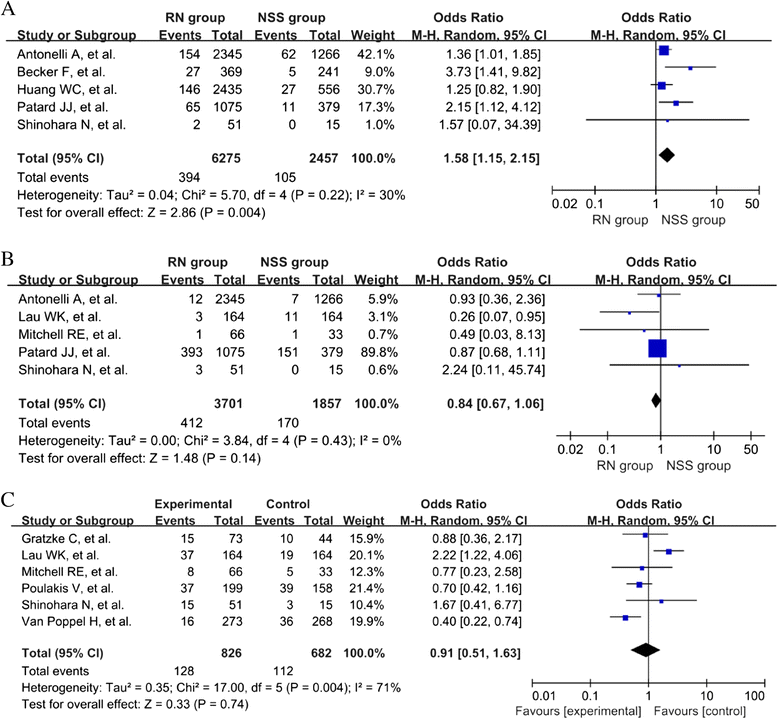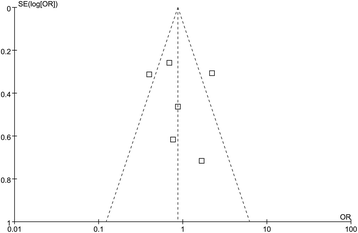Clinical efficacy of radical nephrectomy versus nephron-sparing surgery on localized renal cell carcinoma
- PMID: 25374003
- PMCID: PMC4226856
- DOI: 10.1186/s40001-014-0058-4
Clinical efficacy of radical nephrectomy versus nephron-sparing surgery on localized renal cell carcinoma
Abstract
Background: The aim of the present study was to compare the clinical efficacy of radical nephrectomy (RN) with nephron-sparing surgery (NSS) in treating patients with localized renal cell carcinoma (RCC).
Methods: The literature search was performed in PubMed, MEDLINE Springer, Elsevier Science Direct, Cochrane Library, and Google Scholar up to December 2012. The software Review Manager 5.1 and the STATA software package v.11.0 were used for analyses. The odds ratios (ORs) and its 95% confidence interval (95% CI) were calculated for comparison. Subgroup analyses were performed based on the tumor size of RCC.
Results: In total, 10 studies with 10,174 RCC patients (7,050 treated with RN and 3,124 treated with NSS) were selected. The pooled estimate (OR = 1.58, 95% CI = 1.15-2.15, P = 0.004) showed a significantly lower rate of cancer-specific deaths in the patients treated with NSS compared to RN. However, no statistically significant differences were found in the rate of tumor recurrence (OR = 0.84, 95% CI = 0.67-1.06, P = 0.14) and complications (OR = 0.91, 95% CI = 0.51-1.63, P = 0.74) between the patients treated with NSS and RN. In addition, all the subgroup analyses presented consistent results with the overall analyses.
Conclusions: NSS had no significantly different from RN in tumor recurrence and complications for localized RCC. However, the significantly lower rate of cancer-specific deaths supported the use of NSS not only for RCC with tumor size >4.0 cm but also for tumor sizes ≤4.0 cm compared with RN.
Figures
Similar articles
-
A prospective, randomised EORTC intergroup phase 3 study comparing the oncologic outcome of elective nephron-sparing surgery and radical nephrectomy for low-stage renal cell carcinoma.Eur Urol. 2011 Apr;59(4):543-52. doi: 10.1016/j.eururo.2010.12.013. Epub 2010 Dec 22. Eur Urol. 2011. PMID: 21186077 Clinical Trial.
-
Nephron sparing surgery for appropriately selected renal cell carcinoma between 4 and 7 cm results in outcome similar to radical nephrectomy.J Urol. 2004 Mar;171(3):1066-70. doi: 10.1097/01.ju.0000113274.40885.db. J Urol. 2004. PMID: 14767272
-
Oncological efficacy and safety of nephron-sparing surgery for selected patients with locally advanced renal cell carcinoma.BJU Int. 2007 Dec;100(6):1235-9. doi: 10.1111/j.1464-410X.2007.07225.x. BJU Int. 2007. PMID: 17979923
-
Laparoscopic and partial nephrectomy.Clin Cancer Res. 2004 Sep 15;10(18 Pt 2):6322S-7S. doi: 10.1158/1078-0432.CCR-050003. Clin Cancer Res. 2004. PMID: 15448025 Review.
-
[Results of nephron-sparing surgery for renal cell carcinoma of more than 4 cm in diameter].Prog Urol. 2009 Feb;19(2):69-74. doi: 10.1016/j.purol.2008.10.010. Epub 2008 Nov 29. Prog Urol. 2009. PMID: 19168008 Review. French.
Cited by
-
Tumor Enucleation vs. Partial Nephrectomy for T1 Renal Cell Carcinoma: A Systematic Review and Meta-Analysis.Front Oncol. 2019 Jun 4;9:473. doi: 10.3389/fonc.2019.00473. eCollection 2019. Front Oncol. 2019. PMID: 31214511 Free PMC article.
-
The relationship between histopathology and age factor in patients who were operated for renal masses.Turk J Urol. 2015 Jun;41(2):57-60. doi: 10.5152/tud.2015.54521. Turk J Urol. 2015. PMID: 26328202 Free PMC article.
-
The Benign Renal Masses that Were Exposed after Nephron-Sparing Surgery: "Postsurgical Fatty Tumor." Is It Related to the Surgical Technique?J Kidney Cancer VHL. 2021 Nov 28;9(1):1-8. doi: 10.15586/jkcvhl.v9i1.195. eCollection 2022. J Kidney Cancer VHL. 2021. PMID: 34888127 Free PMC article.
-
Open Partial Nephrectomy vs. Robot-assisted Partial Nephrectomy for a Renal Tumor Larger than 4 cm: a Propensity Score Matching Analysis.J Korean Med Sci. 2021 May 24;36(20):e135. doi: 10.3346/jkms.2021.36.e135. J Korean Med Sci. 2021. PMID: 34032028 Free PMC article.
References
-
- Wood C, Srivastava P, Bukowski R, Lacombe L, Gorelov AI, Gorelov S, Mulders P, Zielinski H, Hoos A, Teofilovici F. An adjuvant autologous therapeutic vaccine (HSPPC-96; vitespen) versus observation alone for patients at high risk of recurrence after nephrectomy for renal cell carcinoma: a multicentre, open-label, randomised phase III trial. Lancet. 2008;372:145–154. doi: 10.1016/S0140-6736(08)60697-2. - DOI - PubMed
-
- Robson CJ, Churchill B, Anderson W. The results of radical nephrectomy for renal cell carcinoma. J Urol. 1969;101:297. - PubMed
Publication types
MeSH terms
LinkOut - more resources
Full Text Sources
Other Literature Sources
Medical




